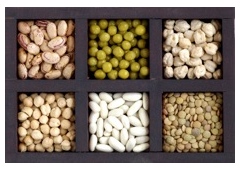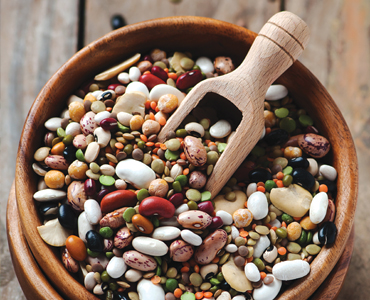
Do cooking conditions affect the nutritional quality of pulses?
By Food in Canada staff
Research & Development Fruit & Vegetables AAFC Agriculture and Agri-Food Canada pulses
 To increase Canadian consumption of beans, lentils, and peas, Dr. Elsayed Abdelaal swapped his lab coat for an apron and got cooking at the Guelph Research and Development Centre where he works as a research scientist for Agriculture and Agri-Food Canada (AAFC).
To increase Canadian consumption of beans, lentils, and peas, Dr. Elsayed Abdelaal swapped his lab coat for an apron and got cooking at the Guelph Research and Development Centre where he works as a research scientist for Agriculture and Agri-Food Canada (AAFC).
Working with a team of researchers, he tested how the different bioactive components (for example, polyphenols) and anti-nutritional qualities (that is, the elements that prevent nutrient absorption) of pulses are impacted when they are cooked in a microwave, a slow cooker, a pressure cooker and a traditional pot. Bioactive and anti-nutritional factors have been associated with nutrient absorption, disease prevention, and an overall healthy diet.
“Pulses can be a major component of the human diet. They contain a lot of healthy attributes that include bioactive compounds, non-gluten protein, and a high amount of slowly digestible starch,” said Abdelaal. “My research explores how cooking conditions of pulses could affect the nutritional quality and make them even healthier.”
In addition to cooking methods, Dr. Abdelaal and his team looked at how different cooking liquids affected the pulses. They tested cooking in water, a salty solution, a sweet solution, and an acidic solution.
What they found is that slow-cooking is most effective at maintaining the bioactive components and minimizing the anti-nutritional ones; especially when combined with a salty cooking solution (water with approximately 0.5 per cent—one per cent salt or about a teaspoon per litre of water).
“When it comes to removing or reducing the anti-nutritional factors that interfere with the absorption of nutrients, you need time for them to diffuse out of the pulses and into the solution,” said Abdelaal. “Giving more time at lower temperatures allows that process to take place without affecting the quality of the product.”
Dr. Abdelaal said the salty solution heats up faster than water and facilitates the movement of harmful elements (such as enzyme inhibitors and gas-producing compounds) out of the seed. While the process still takes time, the salt in the solution makes a slow process a little quicker.
Another key characteristic of high-quality pulses (especially canned/processed pulses) is measured by firmness or texture. The sodium solution is preferable because it improves firmness of the cooked seeds, unlike the sugary and acidic solutions, which can make the beans mushy or harder.
“It’s all interrelated,” he said. “A high-quality product improves the nutritional aspects but also should be attractive for consumption.”
He said that by understanding what makes a high-quality pulse for processing (typically either canning or roasting), more producers and processors will be able to stock grocery shelves with better products to boost consumption.
With this research, in partnership with Saskatchewan Pulse Growers, Dr. Abdelaal believes more Canadians could benefit from increasing or introducing pulses to their diets and getting the best nutrition from the change.
“When you have a high-quality product, people will eat it. And Canadian pulses are top quality.”
Print this page